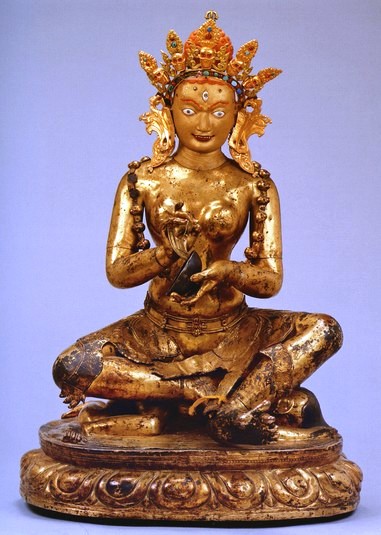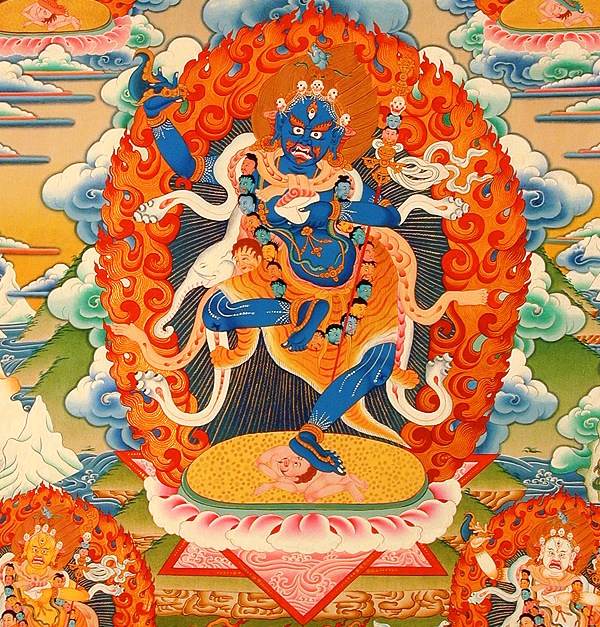Nairatmya. From tibetshop.com
The practice of the dakini Nairatmya was transmitted to Tibet and preserved in the Tengyur, the second part of the Tibetan Buddhist canon. In the Kagyu and Gelug schools, she appears mainly as a spiritual wife of the fierce protective deity Hevajra and very rarely as an independent deity. She is revered as an independent dakini mostly in the Sakya School. It is believed that she transmitted teachings to Shri Virupa, one of the eighty-four mahasiddhas of India, who was a rector of the Nalanda monastery.
The name of Nairatmya can be found in several Buddhist texts. Among them is the Collection of All Tantras, where she is called Vajra Nairatmya (Tib. Dorje Dagmema), Hevajra Tantra, Sadhanamala, Vajrayogini Sadhana, and others.
The image of Nairatmya reflects both the outer aspect of the Tantric practice as a social phenomenon and the inner aspect as a path of mental transformation. Four of the eight wrathful goddesses that are sometimes depicted around her bear the names of yoginis from the lowest social groups in India. Shavari is associated with tribes living in remote rural areas. Pukasi also originates from Indian tribes, and more specifically from tribal hunters. Dombini comes from the dom caste, whose representatives usually engage in “unclean” activities such as preparing corpses for cremation. Chandali is also from the lowest caste, which deals with executions, transporting corpses or cleaning.

Similar activities are described in the stories of Indian mahasiddhas, who often combine their “unworthy” social activities with the role of respected teachers of wealthy aristocrats and kings. The inclusion of such figures in the retinue of Nairatmya symbolizes the Buddhist notion that every being possesses the nature of the Buddha. Her mandala represents a perfect world in which all people, regardless of their social background, have the potential to achieve spiritual realization. The yoginis in her mandala represent the social groups that usually participate in Tantric rituals and especially those of the so-called chakra puja (From Skt. “worship in a circle”).
Regarding the inner yogic practice, Nairatmya is identified with the mystical heat that accumulates in the body. In this role, she is called Chandali as the embodiment of the inner fire, which purifies karmic stains from negative thoughts and emotions stored in the subtle channels of the body. Through specific exercises, this heat rises from the lower part of the body, reaches the crown of the head, melts the nectar of bliss and leads to a state of supreme inner joy.
Nairatmya is associated not only with the fire, which burns delusions, but also with the original sound, which shapes the world through sound vibration. According to the Buddhist tradition, different deities have corresponding sound, as well as all phenomena correspond to a certain sound vibration. In the Indian religious traditions, vowels are generally called “divine mothers” in connection with their role in proclaiming words. Nairatmya symbolizes the Sanskrit vowels and her root syllable, expressing its divine essence, is the vowel A. Her mantra is a combination of vowels in Devanagari, beginning with the sacred syllable OM and ending with SVAHA.* Thus, this dakini is perceived as a source of language, which gives life to everything that exists.

Nairatmya is a cosmic figure who embodies the two basic principles of Vajrayana – emptiness and bliss, as well as the fundamental notion of the absence of an individual self. She is perceived as a source of reality, due to her identification with the empty space from which all forms and phenomena originate. Space as a matrix of the phenomenal world, sound, letters, alphabet, and mantras are accepted in Buddhism as female enteties. Nairatmya is regarded as their incarnation and has an important place in the Tantric Buddhist pantheon.
* OM A Ā I Ī Ṛ Ṝ Ḷ Ḹ E AI О AU AṂ AḤ SVĀHĀ


